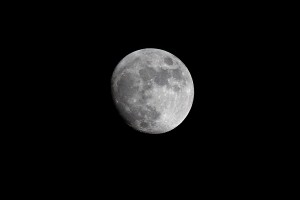
- Picture Angle: 2°
- Construction: 5 elements in 5 groups
- Aperture Diaphragm: Manual
- Minimum Aperture: f/64
- Distance Scale: Graduated down to 143ft (43m)
- Filter: 122mm screw-in
- Dimensions: 135mm x 732mm, 922mm long with focusing unit
- Weight: 3.1kg, 4.3kg with focusing unit
Additionally, it has built-in telescoping lens hood, and came with a 135mm slip-on feather front cap, a slip-on leather rear cap, the focusing unit, and a wooden case. According to Malaysian Internet Resources, “this used to be the longest regular-type Nikkor super telephoto lens for 35mm photography. Magnification is an amazing 24 times that of the 50mm normal lens. The lens was used to be highly useful in photojournalism, sports, wildlife and other types of photography during those days.”
My dad also gave me two of his old Nikon cameras, a Nikon F and a Nikomat EL, both of which were originally used with the 1200mm back in the day. But what I really wanted to know was: Could I get the old super-telephoto lens to somehow play nice with my Canon EOS 5D?
The first thing I had to do was find out if there was an adapter available that would allow Nikon F lenses to fit on a Canon EOS body. Turns out there are quite a few out there, ranging anywhere from $10 to $200 dollars. From what I can figure out, the main differences are that the higher priced adapters may be machined better and are more durable with repeated mounting and unmounting, and some also have a chip built on that allows for focus confirmation. Aside from eBay recommendations, the most common names that kept popping up on photo gear discussion boards were: Novaflex, Fotodiox, and Camerquest.
Novaflex adapters, though generally well regarded in the postings I read, were more expensive and since this was simply an experiment for me at this time, I opted for a $30 consumer-grade adapter from Fotodiox. I’m sure I could’ve gotten one cheaper, but the whole eBay thing kinda freaks me out.

I ordered this adapter and had it within a few days. Upon receiving it, I first tried the adapter on the Nikkor lens. I can see right off the bat that working with Nikon lenses may take some getting used to, even on the Nikon bodies I have – they mount in the opposite direction as do the Canon lenses. The fit, however, was superb – no play between the adapter and the lens. I then attached the lens/adapter combination onto my Canon EOS 5D just as I would any one of my Canon lenses. Again, the fit was superb.
How did it work? Here are a couple of examples to compare magnification. The first image was taken about six months ago with a 200mm lens + 2X extender; the next shot was taken on July 4th with the Nikkor-P 1200mm.


Below is a crop from the shot taken at 1200mm. Lens and camera were mounted on a gear-driven tripod. Mirror lockup was enabled and the camera was fired with a cable release at f/11, 1/50th sec exposure, manually focused. Click on the image for the full-sized crop.

Overall, I’m thrilled with the results, though I’m looking forward to more favorable conditions during which to try it again. Obviously, there is no image stabilization on this lens, so its uses may be limited for anything but stationary objects. Panning would be out of the question. As far as the build quality of the Fotodiox adapter, I think it will adequately suit my needs. Some people have recommended getting an adapter for each individual lens if the cheaper model is used in order to reduce wear and subsequent loosening from repeated mounting and un-mounting, but I suspect I’ll reserve the use of the other lenses for the film bodies and keep the adapter on the 1200mm.
Last night it occurred to me that I might be able to throw my 2X extender into the mix, between the adapter and the camera body. 2400mm Nikkor on a Canon body, anyone? Stay tuned…





Do you want to sell this lens . I would be very interested in buying it your interested. rogaltacdesign @gmail.ca
Gregory,
I haven’t had the lens long enough to know if I really have use for it. There are a few things I’d certainly like to try in order to determine what its limits are in relation to the things I want to shoot, and there are other things I’d like to try, just for fun. I’ll keep you in mind, though, and feel free to check back with me a a later date.
Galen
I have an opportunity to buy one of these, but no idea what it`s worth! Any idea?
Vic,
I really don’t have any idea what this lens is worth. I’ve done a bit of searching online, but haven’t been able to come up with anything. Short of getting it appraised, I don’t know if I’d be able to come up with a value, and it’s unlikely that anyone around my area (Tucson, Arizona) would be qualified to value it. If you’re able to find anything, please let me know.
Galen
I am also interested in this lense… If anyone falls through on it let me know. I have alot of old film med format, large, 35, older lenses to trade or pay cash. Located in New Orleans and Philly at the moment.
stumbled across your site via google, pretty neat, your dad sounds like an interesting man.
thanks,
-Todd
@Todd,
I’ll keep you in mind. 🙂
Galen
Hi Galen
Just out of curiosity, do you have the serial number for the lens? Also, do you have the wood case and original leather front cap?
I have all three.
Hey Timm. Do you know the value of this lens? I have one just like it but do not know what it’s worth.